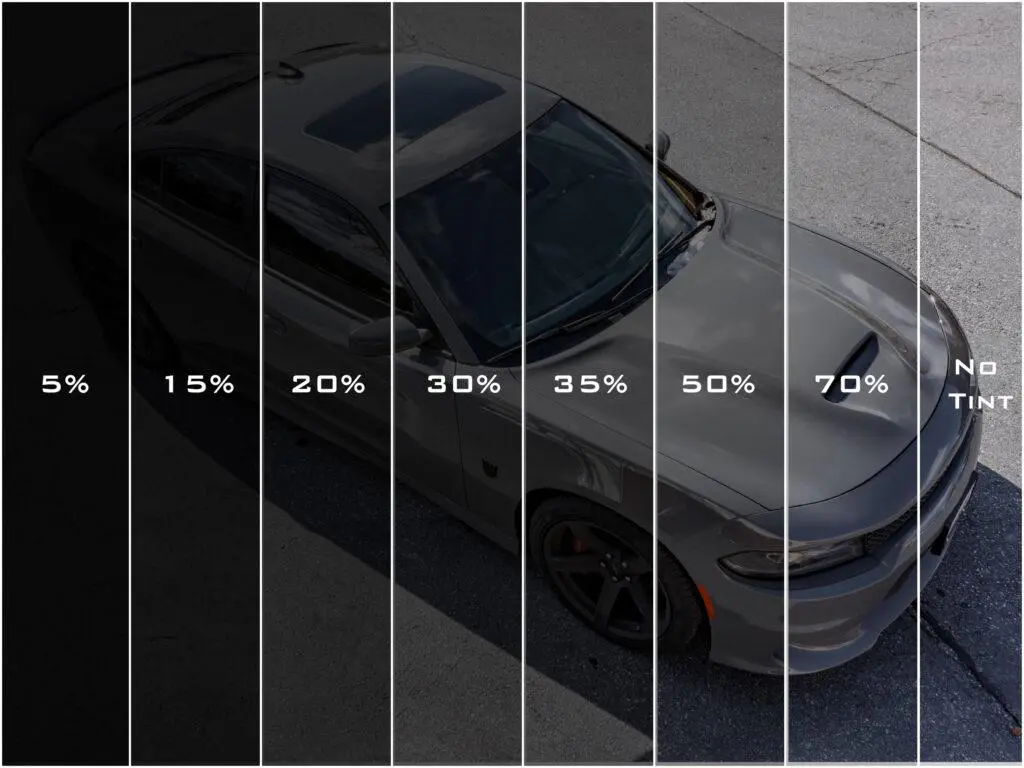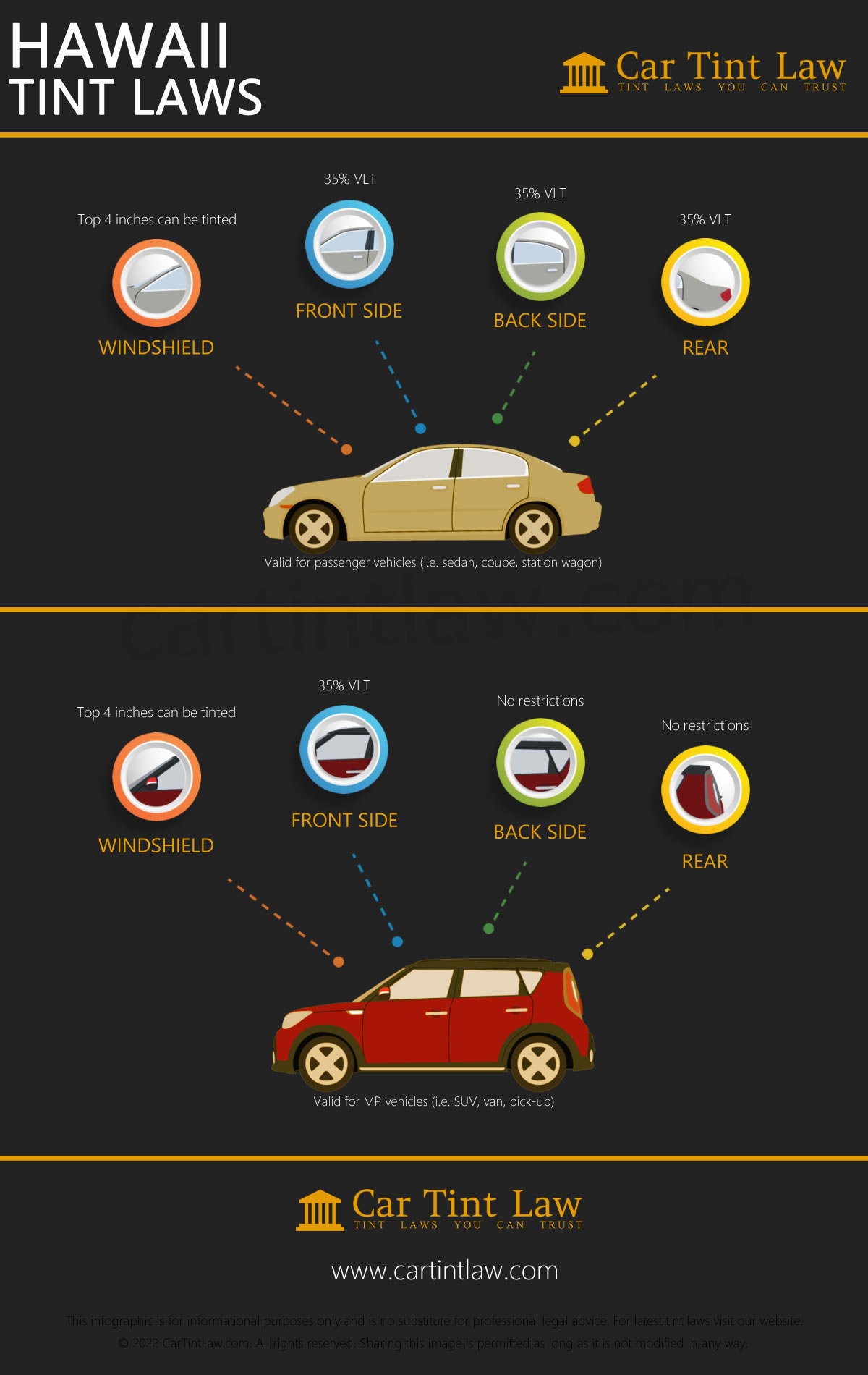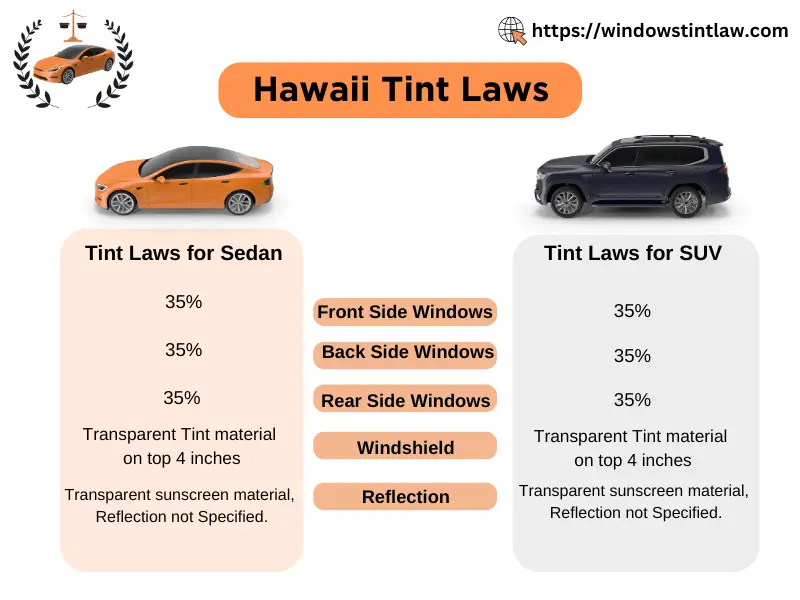Imagine driving along Hawaii’s breathtaking coastlines, the sun casting vibrant hues on the ocean as palm trees sway gently in the breeze. It’s paradise, but the glaring sun can sometimes be a bit too intense.
Here’s where window tinting steps in, offering protection and comfort. Yet, before you decide to tint your car windows, it’s crucial to know Hawaii’s specific tint laws. These laws are designed to keep you safe while allowing you to enjoy the island’s beauty without obstruction.
Are you curious about how these laws affect your driving experience? Understanding them can save you from fines and ensure your vehicle remains compliant. Dive into the details, and discover how Hawaii’s tint law might impact you.
Tint Law Basics
Hawaii’s tint law limits window tinting to ensure safety and visibility. Front side windows must allow over 35% light in. Rear windows can have darker tints, but must follow specific guidelines. Always check local rules to avoid fines.
When driving in Hawaii, you may notice that many vehicles have tinted windows. But did you know there’s a law regulating this? Understanding the basics of Hawaii’s tint law is crucial if you’re considering tinting your car’s windows. This law ensures safety and comfort while driving, balancing your privacy with visibility. ###Understanding Visible Light Transmission (vlt)
The key term here is Visible Light Transmission (VLT). This percentage tells you how much light can pass through your window tint. In Hawaii, the front side windows must allow more than 35% of light in. Rear windows can be darker, but they must still let in more than 35% light. Knowing your VLT percentage helps you stay compliant with the law and avoid fines. ###Exceptions To The Rule
Are there exceptions to the tint law? Yes, there are! Medical exemptions exist for those who need extra protection from the sun. If you think you qualify, you must have documentation from a licensed physician. This exception ensures that those with specific health needs can still drive comfortably. However, without proper paperwork, you could face penalties. ### What happens if you break the tint law? You could receive a fine, and your car might not pass inspection. Repeated offenses can lead to increased fines and more severe consequences. Ensuring your car meets the legal requirements saves you from these hassles. It’s always better to check your tint before hitting the road. ### Selecting the right tint can be overwhelming. How do you decide? Consider both the legal requirements and your personal needs. Visit a professional installer who understands the Hawaii tint law. They can guide you on the best options that meet legal standards and enhance your driving experience. ###I remember when I first considered tinting my car windows. I wanted privacy, but I didn’t want to break the law. After researching, I spoke with a local expert who explained the VLT percentages and legal limits. His advice saved me from potential fines and ensured my car looked great. Have you checked if your vehicle’s tint complies with Hawaii’s law? It’s worth the peace of mind.
Legal Tint Limits
Hawaii’s tint law sets specific limits on how dark car windows can be. Front side windows must allow over 35% of light in. Rear windows may be darker, but must comply with safety standards. These rules help ensure driver visibility and road safety.
Understanding the legal tint limits in Hawaii is crucial if you’re considering modifying your vehicle’s windows. Hawaii’s tint laws are in place to ensure safety and visibility for all drivers on the road. Whether you’re looking to escape the tropical sun or add a bit of privacy to your ride, knowing these regulations will keep you on the right side of the law. Let’s dive into the specifics of Hawaii’s tint laws.Front Windshield Regulations
Hawaii law allows for a tinted strip along the top of your front windshield. This strip cannot extend more than four inches from the top of the windshield. The rest of the front windshield must remain clear, ensuring your view of the road is unobstructed. Imagine driving along the stunning coastline with a clear view of the ocean. A clear windshield not only keeps you safe but also allows you to enjoy the breathtaking scenery.Side Windows Restrictions
The law is more lenient with side windows. For front side windows, the tint must allow over 35% of light to pass through. This means you can have some privacy without compromising too much visibility. Your rear side windows can be tinted darker. This provides added privacy and comfort from the sun’s glare. However, it’s essential to remember that darker tints can make it harder to see at night. Consider if you drive frequently at night. Will a darker tint compromise your ability to see clearly?Rear Window Guidelines
Your rear window can also be tinted, but the rules depend on whether your vehicle has side mirrors. If you have dual side mirrors, you can apply any level of tint to the rear window. This is great for those who want to maximize privacy in the back. Without side mirrors, the rear window must allow more than 35% of light in. This ensures you can see vehicles behind you clearly. Think about how you use your vehicle. Do you often reverse in tight spaces? Having a clearer rear window can make a significant difference in visibility. Understanding these guidelines helps you make informed decisions about tinting your windows. Always check the latest state laws, as they can change. By adhering to these rules, you ensure a safe and enjoyable driving experience in beautiful Hawaii.Penalties For Non-compliance
Failure to comply with Hawaii’s tint law can result in fines and penalties. Violations may lead to increased insurance costs. Staying informed on regulations can help avoid these consequences.
### Penalties for Non-Compliance Understanding Hawaii’s tint law is not just about adhering to legal standards; it’s also about avoiding penalties that can put a dent in your wallet. Complying with these regulations is crucial, as non-compliance can lead to fines, inspection failures, and more. Let’s dive into what could happen if your vehicle’s tint doesn’t meet the legal requirements. ###Fines And Fees
Hawaii’s tint law is clear on the consequences for non-compliance. If your vehicle has illegal tint, you could face fines starting at $250 for the first offense. Subsequent violations can lead to fines of up to $500. These penalties are designed to encourage compliance, ensuring safer driving conditions for everyone. Imagine getting caught in a sudden downpour with limited visibility due to an overly dark tint – it’s a risk not worth taking. ###Inspection Failures
Regular vehicle inspections are mandatory in Hawaii, and failing to meet tint regulations can result in inspection failures. This means your vehicle won’t pass the safety check, preventing you from legally driving it. A failed inspection due to tint issues not only inconveniences you but also requires additional time and money to rectify. Have you ever had plans disrupted because of a failed inspection? It’s frustrating and avoidable with proper compliance. Ensuring your vehicle’s tint adheres to Hawaii’s laws is not just about avoiding penalties; it’s about maintaining a safe and legal driving experience. Taking the time to understand and apply these regulations can save you from unnecessary headaches down the road.
Credit: lovesautodetail.com
Benefits Of Complying
Complying with Hawaii’s tint law offers several benefits for vehicle owners. It enhances safety and helps avoid legal issues. Understanding these advantages encourages responsible vehicle maintenance. Let’s explore why following the tint law is beneficial.
Safety Advantages
Safe driving is a top priority for everyone. Compliant window tint reduces glare from the sun. This enhances visibility, helping drivers see clearly. Improved visibility lowers the risk of accidents. Additionally, legal tint levels help prevent eye strain. Drivers can focus better on the road. Safety isn’t just about physical harm. It’s about mental ease too. Complying with tint laws contributes to a safer driving experience.
Avoiding Legal Issues
Legal complications are a hassle. Non-compliance with tint laws can lead to fines. These fines are often unexpected and costly. Legal issues can also result in vehicle inspections. These inspections might lead to extra expenses. Avoiding these problems is simple. Ensure your vehicle’s tint meets state requirements. Legal compliance saves time and money. It also prevents unnecessary stress. Being aware of tint regulations helps maintain peace of mind.
Choosing The Right Tint
Choosing the right tint for your car in Hawaii is more than just a style choice. It involves understanding the local tint laws and selecting a tint that balances aesthetics, privacy, and legal compliance. With the sun shining bright in Hawaii, a good tint can also protect your vehicle’s interior and improve your driving experience.
Types Of Tint Available
Car tints come in various types, each offering different levels of protection and privacy. You might opt for dyed window tint for a budget-friendly choice that provides a sleek look. Dyed tints are great for reducing glare and have a non-reflective finish.
If you’re looking for more durability, consider metallic or hybrid tints. These types are excellent for blocking UV rays and heat, making them suitable for Hawaii’s sunny climate. However, they may interfere with electronic signals, so it’s something to keep in mind.
Ceramic tints offer top-tier heat rejection and UV protection. They’re pricier but don’t disrupt signals, making them a popular choice among tech-savvy car owners. Have you ever wondered why some cars always look cool and comfy, even in scorching heat? Ceramic tints might be the secret.
Considerations For Car Owners
When choosing a tint, consider your daily driving habits. Are you often on the road during peak sunlight hours? If yes, a tint with high UV protection could be beneficial. Think about your car’s color too; darker cars can heat up quickly, so a tint that reduces heat gain can make a big difference.
Legal compliance is crucial. Hawaii’s tint laws specify how dark or reflective your tints can be. Violating these regulations could lead to fines, so ensure your chosen tint meets state standards. Have you checked if your current tint aligns with local laws?
Finally, consider your budget. While high-end tints offer excellent benefits, they might not fit every budget. It’s wise to weigh the costs against the advantages to find the best tint for your needs. Investing in quality tint can be a smart long-term decision for both comfort and compliance.
Choosing the right tint involves more than aesthetics; it’s about enhancing your driving experience while staying within legal boundaries. What’s your priority when selecting a tint?

Credit: www.cartintlaw.com
Tint Installation Tips
Installing tint on your vehicle windows in Hawaii can enhance privacy. It also reduces glare and protects from harmful UV rays. It’s essential to follow the Hawaii Tint Law. This ensures compliance and avoids penalties. Below are some practical tips for tint installation.
Diy Vs Professional Services
Choosing between DIY and professional installation depends on your skills. DIY kits are cheaper and offer a personal touch. They require precision to avoid bubbles or peeling. Professional services offer expertise and quality. They ensure adherence to tint laws. Consider your budget and skills before deciding.
Maintenance Advice
Proper maintenance keeps your tint looking great. Avoid using harsh chemicals on the tint. Use mild soap and water for cleaning. Ensure windows stay closed for a few days after installation. This helps the tint adhere better. Regularly inspect for bubbles or peeling. Address issues early to prolong lifespan.
Common Misconceptions
Many people misunderstand Hawaii’s tint law. These misconceptions often lead to confusion. Understanding the truth is important for compliance. This section aims to clear up these misconceptions.
Myths About Tinting
Some believe any tint is illegal in Hawaii. This is not true. Hawaii allows window tinting within specific limits. Another myth is that darker tints are always better. Darker does not mean better. It can be unsafe, especially at night. Some think medical exemptions don’t exist. In fact, Hawaii provides medical exemptions for certain conditions.
Clarifying Legal Confusions
Many confuse the percentage of tint allowed. Hawaii’s law states a minimum of 35% VLT for front windows. This means 35% of light must pass through. Back windows have different rules. They can be darker, but not completely black. Some people think tinting affects insurance. Tinting does not usually impact your insurance. Understanding these facts can help avoid penalties.
Future Changes In Tint Laws
Hawaii’s tint laws may change soon. Many car owners in Hawaii stay informed. Laws affect their vehicle choices. Future changes bring questions. What will new laws mean? How should drivers prepare? Exploring potential amendments and impacts offers clarity.
Potential Amendments
Lawmakers consider updates to tint regulations. Changes aim to improve road safety. Some suggest stricter rules. Others push for leniency. Adjustments might include tint darkness limits. New guidelines could affect window locations. Law changes require careful study. Public feedback shapes final decisions.
Impact On Car Owners
New laws affect many drivers. Car owners may need vehicle adjustments. Retinting windows could be necessary. Additional costs might arise. Compliance ensures avoiding fines. Changes also affect vehicle aesthetics. Owners must balance style and legality. Staying informed helps plan for the future.

Credit: windowstintlaw.com
Frequently Asked Questions
What Is The Darkest Tint Legal In Hawaii?
In Hawaii, front side windows must allow over 35% of light. Rear windows can have any tint darkness. Ensure compliance with local regulations for safe driving.
In What State Is 20% Tint Legal?
20% tint is legal in some states, like California for rear windows. Laws vary by state, so check local regulations. Always ensure compliance with state-specific tint laws to avoid fines.
How To Get Tint Exemption In Hawaii?
Apply for a tint exemption through the Hawaii Department of Transportation. Provide medical documentation proving the need for special tint. Ensure your vehicle meets all other safety standards. Approval grants exemption for specific tint regulations. Always carry documentation in the vehicle to show compliance during inspections or traffic stops.
How Much Is A Tint Ticket In Hawaii?
A tint ticket in Hawaii costs around $287. This fine applies if your window tint doesn’t meet legal standards. Ensure your vehicle complies with Hawaii’s tint regulations to avoid penalties. Regular checks can help maintain compliance and prevent unnecessary fines.
Conclusion
Understanding Hawaii’s tint law helps keep you compliant and safe. These laws ensure clear visibility for drivers and law enforcement. Always check your tint’s compliance with local regulations. Incorrect tint can lead to fines or penalties. Stay informed to enjoy a stress-free driving experience.
Regularly review updates on tint laws in Hawaii. This knowledge protects you and others on the road. Make safe choices for your vehicle and community. By following the law, you contribute to road safety. Keep your vehicle within legal limits and enjoy peace of mind.
Stay responsible and drive safely in Hawaii.
